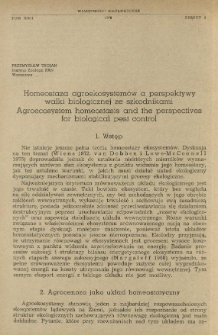- Search in all Repository
- Literature and maps
- Archeology
- Mills database
- Natural sciences
Advanced search
Advanced search
Advanced search
Advanced search
Advanced search

Object
Title: Homeostaza agroekosystemów a perspektywy walki biologicznej ze szkodnikami
Subtitle:
Agroecosystem homeostasis and the perspectives for biological pest control
Contributor:
Polska Akademia Nauk. Komitet Ekologii
Publisher:
Place of publishing:
Description:
Strony 238-2423 ; 24 cm ; Bibliografia na stronie 241 ; Streszczenie w języku angielskim
Type of object:
Abstract:
Discussion on ecosystem homeostasis has supplied means of measuring their state of balance, among which the most important is the persistence in time of such systems. The essence itself of homeostatic systems, however, still remains unknown. Effective functioning of self-regulating mechanisms involves full use of the energy produced in the system.The agroecosystem is among the most widely-spread types of land ecosystems. The central point of the system is man, whose activities determines the physicochemical pressure on the system, its species composition and spatial organization, and it is man who ensures the persistence of the ecosystem in time. An agroecosystem is an open system saturated to a lesser degree by species than its neighbouring ecosystems. The way in which it develops is to render its structure similar to that which occurs in homological land systems, hence the ease with which weed and pest species are accepted, which enrich the homeostatic structure of this system.Biological control of pests of agrocenoses carried out on the basis of the principles in current use is an operation which is insufficiently effective from the aspect of the concept of homeostasis of agrocenoses, since the biocenosis tends to reproduce the preceding qualitative and quantitative structure. Prospects are more promising for action aimed at increasing a substitute food supply for predators and parasites and for forming refuge areas for beneficial fauna, which areas would then become the source of its expansion into cultivated fields. Homeostatic systems themselves acting within agrocenoses are not directed towards maintenance or protection of agricultural production.
References:
1. Dobben W. H. van, Lowe-McConnel R. H. (Ed.) 1975 — Unifying concepts in ecology — The Hague, 302 pp.
2. Elton Ch. 1967 — Ekologia inwazji zwierząt i roślin — Warszawa, 187 pp.
3. Margaleff R. 1968 — Perspectives in ecological theory — Chicago, 111 pp.
4. Tischler W. 1971 — Agroekologia — Warszawa, 484 pp.
5. Trojan P. 1968 — Agrocenoza jako biologiczny układ produkcyjny — Pol. Pismo ent. 38: 647—655.
6. Trojan P. 1974 — Zagadnienie homeostazy ekosystemów — Zesz. probl. Post. Nauk roln. 155: 39—51.
7. Wiens J. A. (Ed.) 1972 — Ecosystem structure and function — Ann. Biol. Coll. Oregon, 176 pp.
Relation:
Volume:
Issue:
Start page:
End page:
Detailed Resource Type:
Resource Identifier:
oai:rcin.org.pl:153810 ; ISSN 0013-2969
Source:
MiIZ PAN, sygn. P.3259 ; click here to follow the link
Language:
Language of abstract:
Rights:
Licencja Creative Commons Uznanie autorstwa 3.0 Polska
Terms of use:
Zasób chroniony prawem autorskim. [CC BY 3.0 PL] Korzystanie dozwolone zgodnie z licencją Creative Commons Uznanie autorstwa 3.0 Polska, której pełne postanowienia dostępne są pod adresem: ; -
Digitizing institution:
Muzeum i Instytut Zoologii Polskiej Akademii Nauk
Original in:
Biblioteka Muzeum i Instytutu Zoologii PAN
Projects co-financed by:
Access:
Object collections:
- Digital Repository of Scientific Institutes > Partners' collections > Museum and Institute of Zoology PAS > Scientific Journals
- Digital Repository of Scientific Institutes > Literature > Journals/Articles
Last modified:
Feb 4, 2025
In our library since:
Dec 29, 2020
Number of object content downloads / hits:
63
All available object's versions:
https://rcin.org.pl./publication/107856
Show description in RDF format:
Show description in RDFa format:
Show description in OAI-PMH format:
| Edition name | Date |
|---|---|
| Z. 3. Homeostaza agroekosystemów a perspektywy walki biologicznej ze szkodnikami / Trojan P. | Feb 4, 2025 |
Objects Similar
Prus, Mirosława
Novak, J. M. Rhodes, O. E., Jr. Smith, M. H. Chesser, R. K.
Kaczmarek, Maria Wasilewski, Aleksander
Suchentrunk, F. Hartl, G. B. Flux, J. E. C. Parkes, J. Haiden, A. Tapper, S.
Dmitriev, S. G. Zakharov, V. M. Sheftel, B. I.
Trojan, Przemysław
Trojan, Przemysław

 INSTYTUT ARCHEOLOGII I ETNOLOGII POLSKIEJ AKADEMII NAUK
INSTYTUT ARCHEOLOGII I ETNOLOGII POLSKIEJ AKADEMII NAUK
 INSTYTUT BADAŃ LITERACKICH POLSKIEJ AKADEMII NAUK
INSTYTUT BADAŃ LITERACKICH POLSKIEJ AKADEMII NAUK
 INSTYTUT BADAWCZY LEŚNICTWA
INSTYTUT BADAWCZY LEŚNICTWA
 INSTYTUT BIOLOGII DOŚWIADCZALNEJ IM. MARCELEGO NENCKIEGO POLSKIEJ AKADEMII NAUK
INSTYTUT BIOLOGII DOŚWIADCZALNEJ IM. MARCELEGO NENCKIEGO POLSKIEJ AKADEMII NAUK
 INSTYTUT BIOLOGII SSAKÓW POLSKIEJ AKADEMII NAUK
INSTYTUT BIOLOGII SSAKÓW POLSKIEJ AKADEMII NAUK
 INSTYTUT CHEMII FIZYCZNEJ PAN
INSTYTUT CHEMII FIZYCZNEJ PAN
 INSTYTUT CHEMII ORGANICZNEJ PAN
INSTYTUT CHEMII ORGANICZNEJ PAN
 INSTYTUT FILOZOFII I SOCJOLOGII PAN
INSTYTUT FILOZOFII I SOCJOLOGII PAN
 INSTYTUT GEOGRAFII I PRZESTRZENNEGO ZAGOSPODAROWANIA PAN
INSTYTUT GEOGRAFII I PRZESTRZENNEGO ZAGOSPODAROWANIA PAN
 INSTYTUT HISTORII im. TADEUSZA MANTEUFFLA POLSKIEJ AKADEMII NAUK
INSTYTUT HISTORII im. TADEUSZA MANTEUFFLA POLSKIEJ AKADEMII NAUK
 INSTYTUT JĘZYKA POLSKIEGO POLSKIEJ AKADEMII NAUK
INSTYTUT JĘZYKA POLSKIEGO POLSKIEJ AKADEMII NAUK
 INSTYTUT MATEMATYCZNY PAN
INSTYTUT MATEMATYCZNY PAN
 INSTYTUT MEDYCYNY DOŚWIADCZALNEJ I KLINICZNEJ IM.MIROSŁAWA MOSSAKOWSKIEGO POLSKIEJ AKADEMII NAUK
INSTYTUT MEDYCYNY DOŚWIADCZALNEJ I KLINICZNEJ IM.MIROSŁAWA MOSSAKOWSKIEGO POLSKIEJ AKADEMII NAUK
 INSTYTUT PODSTAWOWYCH PROBLEMÓW TECHNIKI PAN
INSTYTUT PODSTAWOWYCH PROBLEMÓW TECHNIKI PAN
 INSTYTUT SLAWISTYKI PAN
INSTYTUT SLAWISTYKI PAN
 SIEĆ BADAWCZA ŁUKASIEWICZ - INSTYTUT TECHNOLOGII MATERIAŁÓW ELEKTRONICZNYCH
SIEĆ BADAWCZA ŁUKASIEWICZ - INSTYTUT TECHNOLOGII MATERIAŁÓW ELEKTRONICZNYCH
 MUZEUM I INSTYTUT ZOOLOGII POLSKIEJ AKADEMII NAUK
MUZEUM I INSTYTUT ZOOLOGII POLSKIEJ AKADEMII NAUK
 INSTYTUT BADAŃ SYSTEMOWYCH PAN
INSTYTUT BADAŃ SYSTEMOWYCH PAN
 INSTYTUT BOTANIKI IM. WŁADYSŁAWA SZAFERA POLSKIEJ AKADEMII NAUK
INSTYTUT BOTANIKI IM. WŁADYSŁAWA SZAFERA POLSKIEJ AKADEMII NAUK




































